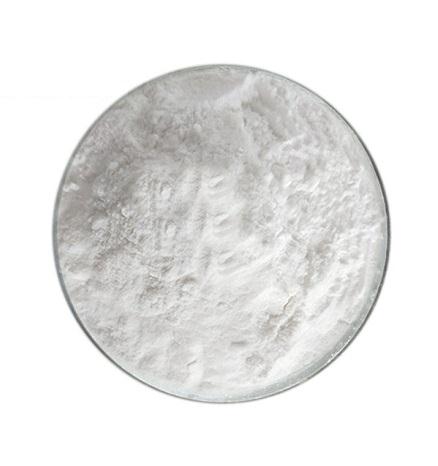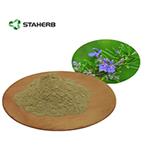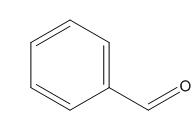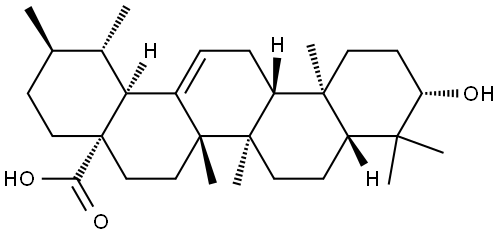Pharmacological action and biochemical effects of Ursolic acid
Jul 20,2022
Ursolic acid is a pentacyclic triterpene acid present in many plants, including apples, bilberries, cranberries, elder flower, peppermint, lavender, oregano, thyme, hawthorn, prunes. Ursolic acid has many pharmacological effects including the antioxidant, antiinflammatory, antibacterial, and antifungal properties.

Pharmacological action
Administration of ursolic acid to the ethanol-fed rats ameliorated the hepatotoxicity by reversing the histological changes; decreasing lipid peroxidation; and increasing the circulatory antioxidants GSH, ascorbic acid, and alpha-tocopherol.When compared with the ethanol-treated cohorts, administering ursolic acid reduced the serum levels of ALT, AST, bilirubin, and restoring serum albumin level.
Experiment research
Ursolic acid inhibits the proliferation of HepG2 liver, MCF-7 breast, and Caco-2 colon cancer cells (EC50s = 87.4, 14.4, and 34.4 μM, respectively).Ursolic acid reverses increases in hepatic steatosis, levels of hepatic triglycerides and free fatty acids, and hepatic TNF-α, IL-1β, IL-6, and IL-8 mRNA expression in a dose-dependent manner in a high-fat diet-induced rat model of non-alcoholic fatty liver disease (NAFLD).4 Ursolic acid also scavenges 2,2-diphenyl-1-picrylhydrazyl (DPPH) radicals (IC50 = 59.7 μg/ml) and inhibits the growth of several strains of Gram-positive and Gram-negative bacteria in vitro including S. aureus, E. coli, P. aeruginosa, K. pneumoniae, and S. flexneri (MICs = 32-512 μg/ml).
Potential biochemical effects
A number of potential biochemical effects of ursolic acid have been investigated, but there has been no clinical study demonstrating benefits to human health. In vitro, ursolic acid inhibits the proliferation of various cancer cell types by inhibiting the STAT3 activation pathway,and may also decrease proliferation of cancer cells and induce apoptosis.Ursolic acid has also been shown to inhibit JNK expression and IL-2 activation of JURKAT leukemic T Cells leading to the reduction in proliferation and T cell activation.Ursolic acid is a weak aromatase inhibitor (IC50 = 32 μM),and has been shown to increase the amount of muscle and brown fat and decrease white fat obesity and associated conditions when added to diets fed to mice.Under physiological concentrations, ursolic acid also induces eryptosis (the apoptosis-like suicidal cell death in defective red blood cells).It has been found to reduce muscle atrophy and to stimulate muscular growth in mice,also shows a potential cardioprotection.
In mice, ursolic acid induces neural regeneration after sciatic nerve injury.In mice with chronic multiple sclerosis, ursolic acid has reduced further damage to neurons and helped rebuild the protective sheaths covering neurons, apparently by suppressing Th17 immune cells and activating precursor cells that mature into myelin-sheath-making cells, called oligodendrocytes.Ursolic acid improves domoic acid-induced cognitive deficits in mice.Ursolic acid improves high fat diet-induced cognitive impairments by blocking endoplasmic reticulum stress and IκB kinase β/nuclear factor-κB-mediated inflammatory pathways in mice.
Ursolic acid attenuates lipopolysaccharide-induced cognitive deficits in mouse brain through suppressing p38/NF-κB mediated inflammatory pathways.Ursolic acid ameliorates cognition deficits and attenuates oxidative damage in the brain of senescent mice induced by D-galactose.Ursolic acid enhances mouse liver regeneration after partial hepatectomy.[19] Ursolic acid enhances the cellular immune system and pancreatic beta-cell function in streptozotocin-induced diabetic mice fed a high-fat diet.UA increased skeletal muscle mass, as well as grip strength and exercise capacity. Improved endurance, reduced the expression of the genes involved in the development of muscle atrophy, and decreased indicators of accumulated fatigue and exercise-induced stress.
In rats, ursolic acid ameliorated high-fat diet-induced hepatic steatosis and improved metabolic disorders in high-fat diet-induced non-alcoholic fatty liver disease.
- Related articles
- Related Qustion
- What is the benefits and side effects of Ursolic acid? Nov 5, 2024
Ursolic acid is a pentacyclic triterpenoid identified in the epicuticular waxes of apples as early as 1920 and widely found in the peels of fruits.
- Does Ursolic acid have weight loss benefits? Mar 12, 2024
Yes, the current study suggests that ursolic acid (UA) significantly ameliorates the progression of obesity.
- Ursolic acid: Source; Biological activity and Mechanism of action Dec 25, 2023
Ursolic acid is a pharmacologically active pentacyclic triterpenoid derived from medicinal plants, fruits and vegetables.
Lapatinib is an oral tyrosine kinase inhibitor of small molecule epidermal growth factor (EGFR: ErbB-1, ErbB-2).....
Jul 19,2022APIBenzaldehyde is widely found in plant kingdom, especially in rosaceae, mainly in the form of glycosides, such as amygdalin in bitter almonds, in stem skins, leaves or seeds.....
Jul 20,2022APIUrsolic acid
77-52-1You may like
- Diosgenin:Uses,Functions and Synthesis
Dec 12, 2025
- Biosynthesis of Cyclopamine from Cholesterol
Dec 10, 2025
- Synthesis of ribociclib
Dec 10, 2025
- Ursolic acid
-

- 2025-12-14
- CAS:77-52-1
- Min. Order:
- Purity: 0.99
- Supply Ability:
- Ursolic acid
-

- $0.00 / 1g
- 2025-12-13
- CAS:77-52-1
- Min. Order: 1g
- Purity: ≥98.0%
- Supply Ability: 10kg/month
- ursolic acid
-

- $0.00 / 1kg
- 2025-12-13
- CAS:77-52-1
- Min. Order: 1kg
- Purity: 25-98%
- Supply Ability: 1000kg






